Research often unfolds as a multistage process. The solution to one question can spark several more, inspiring scientists to reach further and look at the larger problem from several different perspectives. Such projects can often be the catalyst for collaborations that leverage the expertise and capabilities of different teams and institutions as they grow.
For half a century, scientists have delved into the mysteries of 1T phase tantalum disulfide (1T-TaS2), an inorganic layered material with some intriguing quantum properties, like superconductivity and charge density waves (CDW). To unlock the complex structure and behavior of this material, researchers from the Jozef Stefan Institute in Slovenia and Université Paris-Saclay in France reached out to experts utilizing the Pair Distribution Function (PDF) beamline at the National Synchrotron Light Source II (NSLS-II), a U.S. Department of Energy (DOE) Office of Science User Facility located at DOE’s Brookhaven National Laboratory, to learn more about the material’s structure. While the team in Slovenia had been studying these kinds of materials for decades, they were lacking the specific structural characterization that PDF could provide.
The results of this collaboration, recently published in Nature Communications, revealed a hidden electronic state that could only be seen by a local structure probe like the pair distribution function technique. With a more complete understanding of 1T-TaS2’s electronic states, this material may one day play a role in data storage, quantum computing, and superconductivity.










Leave a reply